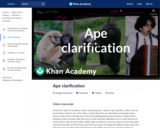
Ape clarification - that they have no tails.
- Subject:
- Biology
- Life Science
- Zoology
- Material Type:
- Lesson
- Provider:
- Khan Academy
- Provider Set:
- Khan Academy
- Author:
- Sal Khan
- Date Added:
- 03/17/2011

Ape clarification - that they have no tails.
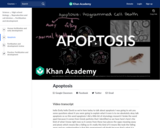
How apoptosis is different from cell death by injury. Role in development and body maintenance.

Some applications of DNA technologies.

Using the Hardy-Weinberg equation to calculate allele and genotype frequencies. Created by Sal Khan.

See the many birds that spend their summer in the Arctic in this video segment from Nature.

How humans have shaped plants and animals through artificial selection and domestication.

Binary fission, budding, mitosis, fragmentation, parthenogenesis and sexual reproduction.

Students are introduced to the concept of engineering biological organisms and studying their growth to be able to identify periods of fast and slow growth. They learn that bacteria are found everywhere, including on the surfaces of our hands. Student groups study three different conditions under which bacteria are found and compare the growth of the individual bacteria from each source. In addition to monitoring the quantity of bacteria from differ conditions, they record the growth of bacteria over time, which is an excellent tool to study binary fission and the reproduction of unicellular organisms.
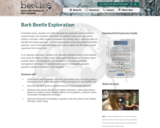
In forested areas, students are often intrigued by mysterious sticks covered in carved tunnels–but students often think the patterns were made by human artists or termites. After students complete this activity, they’ll have the skills to identify bark beetle galleries, to make explanations about the patterns of beetle galleries, and to interpret what these tracks tell us about the life history of the organisms that made them.
In an optional discussion, students can consider outbreak levels of bark beetles that cause the death of many trees, make arguments based on evidence about possible effects on ecosystems, then brainstorm and critique possible management strategies. An optional extension for investigating student questions about bark beetles is also included.

This video segment explores the world of the beaver, including the biology of the species and, more importantly, its ability to transform an ecosystem for its own benefit.

Life and photosynthesis start to thrive in the Archean Eon.

Students act as if they are biological engineers following the steps of the engineering design process to design and create protein models to replace the defective proteins in a child’s body. Jumping off from a basic understanding of DNA and its transcription and translation processes, students learn about the many different proteins types and what happens if protein mutations occur. Then they focus on structural, transport and defense proteins during three challenges posed by the R&D; bio-engineering hypothetical scenario. Using common classroom supplies such as paper, tape and craft sticks, student pairs design, sketch, build, test and improve their own protein models to meet specific functional requirements: to strengthen bones (collagen), to capture oxygen molecules (hemoglobin) and to capture bacteria (antibody). By designing and testing physical models to accomplish certain functional requirements, students come to understand the relationship between protein structure and function. They graph and analyze the class data, then share and compare results across all teams to determine which models were the most successful. Includes a quiz, three worksheets and a reference sheet.
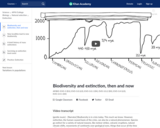
Overview of biodiversity and extinction.

Students explore the biosphere's environments and ecosystems, learning along the way about the plants, animals, resources and natural cycles of our planet. Over the course of lessons 2-6, students use their growing understanding of various environments and the engineering design process to design and create their own model biodome ecosystems - exploring energy and nutrient flows, basic needs of plants and animals, and decomposers. Students learn about food chains and food webs. They are introduced to the roles of the water, carbon and nitrogen cycles. They test the effects of photosynthesis and transpiration. Students are introduced to animal classifications and interactions, including carnivore, herbivore, omnivore, predator and prey. They learn about biomimicry and how engineers often imitate nature in the design of new products. As everyday applications are interwoven into the lessons, students consider why a solid understanding of one's environment and the interdependence within ecosystems can inform the choices we make and the way we engineer our communities.

Introduction to how water, carbon, nitrogen, and phosphorus are cycled through ecosystems.

This video segment from Evolution: "Extinction!" shows the impact of invasive species on native ecosystems.

The documents in this Google folder support instruction in Biology.
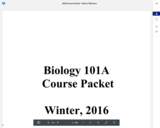
Lab Manual for BIO101 at Mt Hood Community College. The associated textbook is available at https://openoregon.pressbooks.pub/mhccbiology101/

Biology 2e is designed to cover the scope and sequence requirements of a typical two-semester biology course for science majors. The text provides comprehensive coverage of foundational research and core biology concepts through an evolutionary lens. Biology includes rich features that engage students in scientific inquiry, highlight careers in the biological sciences, and offer everyday applications. The book also includes various types of practice and homework questions that help students understand—and apply—key concepts.
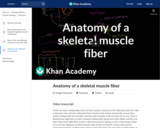
This 17-minute video lesson looks at understanding the structure of a muscle cell. [Biology playlist: Lesson 50 of 71].